Asparagus is a dietary product with valuable qualities and beneficial properties. This vegetable ripens in April and is distinguished by its juiciness and different colors. Due to early ripening, you can replenish the body with vitamins and minerals spent over the winter already in mid-spring, without waiting for traditional summer vegetables. Let's figure out at what age children can be given asparagus.
What is asparagus, what does it look like?
Asparagus is a very healthy, dietary vegetable crop. Appears in the form of shoots, stems or bushes of pods. This is an early vegetable, ripening in early April. The varietal species includes more than two hundred varieties.
Asparagus white and green
The young fruit is considered the most tender and delicious. It retains all the beneficial properties. Asparagus is considered a delicacy. Only the upper parts of the sprout are used in cooking. Previously, asparagus was prepared only in the best restaurants in Europe. It began to be cultivated in Greece. The oldest cookbook includes recipes for asparagus dishes. Asparagus is close to the origin of the onion and leek family. Asparagus goes well with eggs, bacon and shrimp. Italians often use it in making pizza and pasta bases.
Famous chefs recommend selecting only the youngest and juiciest fruits to prepare culinary masterpieces.
Asparagus Recipes for Kids
Vegetable puree soup
- Potatoes – 2 pcs.;
- Onion – 1 pc.;
- Green asparagus – 1 kg;
- Butter – 100 g;
- Olive oil – 100 g;
- Parsley – 1 bunch.
Cook the asparagus in boiling water until half cooked. We clean the vegetables, cut the potatoes into cubes, finely chop the onion. Lightly fry the ingredients together with butter and olive oil. Cut the boiled asparagus, put it in a container along with the vegetables, add water and cook until they are softened. Beat the resulting mass in a blender, lightly salt and pepper. Sprinkle the finished soup with chopped parsley.
Italian pie with three types of cheese
- Asparagus – 200 grams;
- Ricotta – 200 grams;
- Mozzarella – 200 grams;
- Any hard cheese – 200 grams;
- Egg – 2 pcs.;
- Cream – 300 grams;
- Wheat flour – 200 grams;
- Butter – 80 grams.
Grind the flour with butter, add a pinch of salt and a tablespoon of water, knead the dough until smooth. Wrap in cling film and put in the refrigerator for half an hour. Separately, cook asparagus, cut ricotta and mozzarella into small cubes, and three hard cheese.
Beat eggs and add cream, cheeses, asparagus, mix thoroughly. Roll out the dough and place in a mold, bake for 25 minutes at 180 degrees. Then pour over the egg-cheese mixture and bake for another half hour until golden brown.
Vegetable casserole
- Asparagus – 150 grams;
- Eggs – 3 pcs.;
- Potatoes – 0.5 kg;
- Cauliflower – 200 grams;
- Corn – 150 grams;
- Peas – 150 grams;
- Carrots – 1 pc.;
- Onion – 1 pc.;
- Hard cheese – 100 grams.
Boil the potatoes separately until tender and peel. Cook the asparagus in salted boiling water for five minutes and rinse in cold water. We also cook the cauliflower, peas and corn in boiling salted water for five minutes and leave to drain. Mash the potatoes, add two eggs, salt and pepper to taste. You can add a little chopped garlic. Mix the mixture until puree is formed.
Grate the cheese and mix with cabbage, peas and corn. Add chopped carrots and onions. Break the remaining egg and mix again. Place half of the mashed potatoes in a baking dish and spread evenly in one layer.
Place chopped asparagus on top of the potatoes, then add the rest of the mashed potatoes. Finally, distribute the vegetable mixture and bake for 35 minutes at 180 degrees. The finished, slightly cooled casserole is turned upside down onto a plate.
Chicken and egg salad
- Chicken (fillet or breast) – 200 grams;
- Eggs – 2 pcs.;
- Asparagus – 200 grams;
- Vegetable oil for frying;
- Olive oil and lemon juice for dressing.
Boil chicken and eggs separately. Finely chop the asparagus and fry in vegetable oil. Cut the chicken into slices, eggs into cubes. Mix the ingredients, season with olive oil and the juice of half a lemon. The salad can also be sprinkled with sesame seeds. Due to the fried ingredients, it is better not to give this dish to a child under 2.5-3 years old. You will find even more recipes for children's salads at the link /.
Asparagus side dish
If you whittled wooden sticks with a penknife as a child or know how to use a potato peeler, you already know how to prepare asparagus for cooking. Its stems are peeled downwards from the middle, since the tender ends of the vegetable do not need to be peeled.
Having trimmed the bottom of the stems so that the branches in the bunch are the same length, we tie the bunch and put it in a saucepan with boiling and salted water (if desired, you can add a couple of lemon slices to it) with the tips facing up. The tips are more tender than the stems and will cook perfectly just by steaming. Depending on the variety, asparagus cooks for 5-15 minutes. Green cooks faster than white and purple.
After cooking, asparagus should be dipped in cold water, which will allow it to retain its color and acquire a pleasant crunchiness. Let the water drain and the asparagus dry or dry it on a napkin. Drizzle the side dish with olive oil (butter will also work), sprinkle with lemon juice - and your asparagus is ready! You can serve it with almost anything, including as an independent vegetable dish.
Asparagus green, white, purple, soy, medicinal: description
Herbaceous types of asparagus are used in cooking, as they have excellent taste and a number of useful elements. The microelements contained in vegetables also have medicinal properties.
Green asparagus is the most common. The Mediterranean coast is considered its homeland. The taste is no different from white. It contains vitamin group A and B, selenium, potassium, phosphorus. The price of green asparagus is the most affordable. Harvesting throughout the year. Prone to long-term storage.
White asparagus is a favorite of foreign restaurants and is considered the most delicious. Harvest ripening period is spring-summer. Complete removal of light results in white asparagus being harvested. The vitamin composition of white asparagus is represented by vitamins A, B, C, and a high content of calcium and potassium.

White asparagus
Purple asparagus is a very interesting and individual variety. Grows in complete darkness, with short periods of sun. The purple tastes a little different from its comrades, has slight deviations in taste and is a little bitter. Thermal exposure changes the color towards green.
Purple asparagus
The soy product is obtained through the processing of soybeans. The bean mass is soaked, pressed and separated from the soy milk. When such liquid is boiled, a film accumulates, which is then dried and called soy asparagus. The main quality of such asparagus is the prevention of oncology and osteoporosis. Soy asparagus has an original aroma and taste. It contains choline, calcium, iron, lecithin.
Soy asparagus
Medicinal asparagus has a number of unique healing properties. Consumption of green and soybean crops actively affects the functioning of important organs of the heart, liver and intestines. Doctors strongly recommend eating asparagus for obesity, epilepsy, arthritis, and allergic diseases.
Recommendations for use
Asparagus can be used for food both raw and processed. The benefits and harms of raw asparagus lie in the fact that the plant retains all its properties in full in the absence of heat treatment. But, of course, you should not overuse raw stems, otherwise they will be harmful and lead to stomach upset.
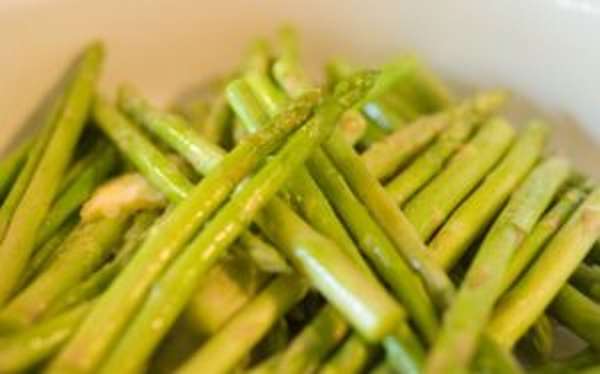
- It is best to steam asparagus - vitamins and minerals are lost to a minimum. In this case, cooking the asparagus should not last long; it just needs to be slightly softened and then served as a side dish.
- The benefits of boiled asparagus will be greatest if you use the freshest stalks possible. It is better to cook asparagus immediately after purchase.
- If the leaves and stems of the plant have wilted a little, the product can be placed in clean cool water with added sugar for several hours - the asparagus will “come to life” in the nutrient solution.
Before cooking, it is customary to trim the long stems of the plant. This is done in the following way: the asparagus shoot is taken by the ends, bent in the middle and cut off where it naturally breaks. The remaining part of the plant must be peeled before processing or eating raw.
Important! The lower part of the plant is not usually eaten - the hemp is too hard and unpleasant to the taste, although useful substances are also present in them.

Benefits of asparagus for women
Since the plant belongs to the category of seasonal products and has a short shelf life, it is customary to preserve it for the winter. Pickled asparagus, found in many stores, is a fairly healthy product that retains maximum valuable properties. The composition still contains vitamins B and PP, the minerals calcium, magnesium, phosphorus and sodium, and the calorie content is only about 15 kcal per 100 g.
The pickled plant is often used in salads. It is useful to use it on a diet and if you are prone to vascular and heart diseases.
However, the benefits and harms of pickled asparagus for the body can be ambiguous for people with joint diseases. The product should be used with caution if you have stomach and intestinal ailments; canned asparagus in large quantities can be harmful.
The beneficial properties of asparagus in nutrition can be harmful in certain diseases. It is prohibited to consume the plant in any form:
- with acute gastric or duodenal ulcer;
- with pancreatitis and colitis in a state of exacerbation;
- for rheumatism;
- for cystitis and prostatitis.
In addition, asparagus, like any product, can cause allergies and thus be harmful. It is recommended to try it in small dosages for the first time.
For the female body, the herb is useful because it stimulates libido, stimulates libido and stabilizes hormonal levels. Asparagus is used in the complex treatment of female infertility.
The optimal amount of B vitamins has a positive effect on metabolism, promotes rapid elimination of toxins and weight loss.
The herb is often used for cosmetic purposes as it has an anti-aging effect.

Asparagus also helps improve libido; for men it acts as a kind of natural Viagra. There is even written evidence that the Greek and Egyptian pharaohs were recommended to eat this herb on a regular basis to increase their potency.
In addition, the herb helps regulate blood pressure and improve the condition of capillaries and blood vessels. It helps in the fight against inflammatory processes in the prostate and helps cope with diseases of the genitourinary system.
To get the maximum effect, it is better to eat asparagus fresh and not even store it in the refrigerator.
It should be remembered that white asparagus contains a lot of sugar, so this should be taken into account by diabetics and those who are trying to lose extra pounds. Purple and green grass is much richer in vitamins and minerals.
Asparagus can cause unpleasant urine and body odor. However, these manifestations disappear after a few hours. This is due to the fact that it contains sulfur compounds that can react with gastric juice. However, this problem does not always arise and directly depends on the genetic characteristics of a particular person.
There is still a lot of controversy regarding the harm of asparagus. Some scientists believe that the herb promotes the accumulation of oxalates in the body, which inevitably leads to the development of urolithiasis. Other scientists say that a plant that has a diuretic effect cannot cause the development of this disease. In order not to think about this issue, you should not just eat asparagus uncontrollably. It is believed that the benefits of the plant can be obtained by consuming 4-5 shoots a day, but it is impossible to eat more, since asparagus has a rather specific taste.
Since ancient times, people have noticed the positive effect of asparagus on the male body. The fact of improving potency has been recorded by several generations of scientists. The plant has a positive effect on sperm motility and their ability to fertilize an egg. The product is useful for males suffering from problems with conception, decreased sexual desire, inflammatory processes of the prostate gland, difficulty urinating, etc.
Asparagus is able to regulate the production of sex hormones, easing the condition of women with PMS and menopause. The folic acid content makes the product useful for pregnant women, helping the baby to form correctly in the womb.
The product is able to reduce the amount of air in the intestines (prevent bloating), which has a beneficial effect on the condition of women during menstruation - pain decreases, mood improves, hormonal levels remain stable.
The juice of the plant can be used to make homemade cosmetics. Lotions, creams, masks and other products will help improve the condition of the skin and hair, relieve problems with inflammatory formations on the face, neck and décolleté, and cope with hair loss.
Like any food product, asparagus has some specific characteristics that can negatively affect the condition of a person suffering from certain ailments.
The plant should not be eaten by people with individual intolerance, those suffering from stomach and duodenal ulcers, or advanced oncological processes.
Depending on age and gender, asparagus has different effects on the human body.
Despite the undoubted benefits of asparagus, it is not suitable for everyone. Asparagus is contraindicated:
- in case of individual intolerance to the product and in case of allergic reactions;
- for gastrointestinal diseases (gastritis, gastric and duodenal ulcers);
- for cystitis and renal colic;
- when breastfeeding;
- in childhood (up to 2 years);
- for cancer in advanced form.
The product is harmful to the body because it provokes itching and inflammation in allergy sufferers - red itchy spots appear on the face and body. In case of exacerbation of inflammatory processes in the gastrointestinal tract, the drug has an irritating effect on the walls of the stomach and intestines.
Another negative property is that with frequent consumption of the product, an unpleasant odor begins to emanate from the body, since the composition contains a large amount of sulfur, which is released through the pores of the skin.
Asparagus: composition, nutritional and energy value, proteins fats carbohydrates
Asparagus has a rich supply, it includes proteins, dietary fiber, carbohydrates, vitamin group B, C, E, folic acid, iron, calcium, selenium, copper, vital elements and minerals. Asparagus has a rich protein composition. It helps the human body replenish protective functions, cell building functions and tissue repair. The daily protein requirement is seventy grams of asparagus. One hundred grams of soy vegetable contains up to 50 grams of pure protein, which means the product has a high energy value.
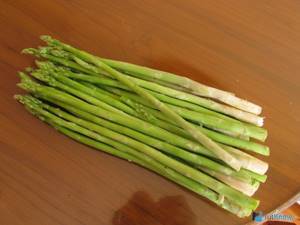
Green asparagus
100 grams of the plant contains more than 6 grams of carbohydrates and 50 grams of protein. The vegetable contains aspartic acid, which plays an important role in the metabolic and digestive process. Coumarins in asparagus, when eaten, will help cope with vascular diseases and prevent the formation of blood clots.
Chemical composition of asparagus
Asparagus is a unique plant with a rich vitamin composition, as well as an incredible amount of macro- and microelements, which make it especially beneficial for men's health.
- Vitamin A (756 mcg) is an antioxidant that slows down the aging process and promotes regeneration, normalizes the immune system and promotes protein synthesis;
- β-carotene – strengthens the immune system, helps increase the body’s resistance to infections, and also increases stress resistance;
- Vitamin C (5.6 mg) is an essential component that helps restore, strengthen the nervous system and concentrate attention, as well as relieve insomnia and depression.
Read also There are rose bushes growing in the garden
Interestingly, asparagus contains substances such as asparagine and coumarins. They help produce proteins and strengthen the heart muscle.

Varieties of asparagus and the vitamins they contain:
- green and purple: A, B1, B2, B4, B9, C and E;
- white: A, B1, B2, C, E;
- soybean: A, B1, B2, B5, B6, B9, B12, C and PP;
- legume: A, B1, B2, B4, B9, C, E;
- marine: A, B1, B15 and C.
When can you give it to your child?
You can give asparagus to children at ten months in the absence of food allergies, digestive problems and chronic diseases. However, it is better to postpone the introduction until a year. Until two or three years of age, only boiled vegetables are given. For the first time, offer your baby half a teaspoon of vegetable puree and observe the baby’s reaction.
If the child feels well, you can continue to give asparagus, but in a limited amount. A one-year-old baby can eat 50-60 grams of vegetables, no more than once a week. After 1.5-2 years, you can increase the portion to 80-100 grams. Be prepared that your baby's urine may become dark in color and have a strong, unpleasant odor. This is a standard reaction to this product.
If your baby shows signs of food allergies or other problems, eliminate the vegetable from the diet and consult a doctor. Pickled asparagus is prohibited for children, as it contains a large amount of spices and vinegar, which is dangerous for the baby. It is important to choose a fresh product and prepare it correctly.

What vitamins are in asparagus?
Asparagus contains a huge amount of vitamins:
- Vitamin A, beta-carotene, which has a beneficial effect on vision and skin. 100 grams of asparagus contain about 4 grams of vitamin.
Microelements - calcium and phosphorus in asparagus are very useful for bone development and blood circulation.
- Asparagus contains zinc, which helps heal old wounds and damaged tissue faster.
- Asparagus also contains iodine, which is beneficial for women's health during pregnancy.
- Potassium, which acts as a diuretic, is why it is recommended to consume asparagus when losing weight and dieting
- Vitamin P in the form of nicotinic acid, which prevents vitamin deficiency, treats hepatitis and cirrhosis of the liver
- Vitamin B9 is found in the form of folic acid. This product is recommended for pregnant women for normal growth and development of the fetus.
- Also contains vitamins C and E in increased quantities
Main conclusions
Most of the usual products often have a calorie content or composition that does not fit into the framework of the diet or nutritional program. However, you can always find a useful alternative that will allow you to lose weight without unnecessary stress:
- A number of products must be replaced not only because of their high calorie content, the presence of sugar, starch or fat, but also because of the risk of developing allergies or an individual reaction of the body.
- Most fruits and vegetables can be replaced with analogues from the same group, chicken eggs - containing protein, meat or fish, snacks and chips - with dried fruits and vegetables, and sweets - with their dietary options (marshmallows, marshmallows).
- It is important not only what to eat on a diet, but also in what quantities. Especially when it comes to sweet fruits, dairy products and dietary baked goods.
Within the framework of the PN system, you can find many alternatives to the usual treats, thus adding variety to the diet while controlling weight and mass gain. By choosing healthy and safe options, those losing weight have the opportunity to discover a new palette of tastes and interesting combinations of seemingly quite ordinary products.
Asparagus: benefits and harm for the body of women, men, children
Eating asparagus is very beneficial for the human body:
- Asparagus has a beneficial effect on the health of a pregnant woman. It contains folic acid, which will help cope with anemia and bear a healthy fetus. A woman's daily intake of folic acid is 0.3 mg
- Asparagus has global significance for men's health. Doctors of ancient Egypt recommended that their rulers eat asparagus dishes to increase potency. It is used to prevent prostate diseases. Asparagus contains aspargine, which reliably fights male diseases
- Asparagus is also of no small importance in the treatment of diabetes. It completely saturates the body with nutrients, without extra calories. If you constantly consume asparagus dishes, a person’s blood sugar level returns to normal, the functioning of the pancreas significantly improves, and insulin is produced faster
- Asparagus is good for young children, as asparagus contains fibers that improve digestion, have a beneficial effect on the microflora of the growing body, and reduce the formation of gases
Asparagus shoots
Useful properties of asparagus
General Use
- Helps in the fight against cancer. Research has shown that vegetables can be used as a cancer-reducing agent. The saponins contained in the drug have a beneficial effect on the body, as they can cause the death of cancer cells.
- In addition, it prevents the further growth and spread of harmful cells. Another compound, sulforaphane, has chemopreventive properties. Folate reduces the risk of pancreatic, colon, and esophageal cancer.
- Improves urinary tract health. The health of the urinary tract is determined by the health of the bladder and kidneys. Asparagus can support the functioning of these organs. Due to their antibacterial properties, green vegetables inhibit the growth of bacteria that can potentially cause various infections. Vegetables can be used as a natural diuretic. The diuretic properties of asparagus help flush out kidney waste and prevent the formation of stones.
- Fights inflammation. Asparagus has antioxidant properties, making it an excellent food for fighting inflammation. Contains substances that reduce inflammation, especially those associated with heart disease. Research has shown that the anti-inflammatory properties of this product can relieve headaches, back pain, rheumatism and gout.
- During menstruation. During menstruation, women may experience lethargy and general fatigue. During this time, the body must be supplemented with useful substances, including B vitamins, which are rich in asparagus. Vegetables can also be used as medicine to treat menstrual irregularities. Once in the body, it helps produce estrogen and soothes menopausal symptoms.
- Supports healthy skin and hair. Asparagus can be used as a skin cleanser. This can help get rid of acne and improve skin tone. Vitamin C in vegetable salad nourishes the skin and prevents drying, while folate improves hair condition.
- Strengthens the heart. Vitamin K found in asparagus prevents hardening of the arteries and keeps calcium in the lining of the arteries. Vegetables can also help lower blood pressure. Soluble fiber reduces the risk of heart disease. Regular consumption of fiber can also lower blood pressure and cholesterol levels.
- The plant contains thiamine, which regulates homocysteine levels in the blood. Excess homocysteine increases the risk of heart disease. Phytonutrients and ascorbic acid help remove excess cholesterol from the blood and improve heart health, while folate prevents heart disease.
- Supports brain health. Asparagus is an excellent source of vitamins E and C. These two nutrients form a powerful combination that helps reduce the risk of Alzheimer's disease. Vegetation helps prevent dysfunction and cognitive decline, especially in older adults. It can also be used to get rid of depression. Folic acid improves mood and helps cope with irritability, so the product can be used by people with epilepsy and seizures.
- Regulates digestion. The cellular tissue found in asparagus aids digestion by helping food move through the intestines. Inulin is a substance that is directly responsible for improving digestion. Moreover, the product is rich in water, which in turn helps prevent constipation and improves digestive health. The prebiotic properties of vegetables support the functioning of beneficial bacteria in the intestines, thereby creating a balance between the microorganisms living there. Asparagus can be used to dilate the stomach or to get rid of excess water in the body.
- Improves bone health. Very often, low levels of vitamin K in the body weaken bone tissue, which can lead to fractures. Asparagus is rich in this nutrient - one cup of vegetables contains about half of the daily value of vitamin K. It has a significant effect on calcium absorption and also prevents calcium loss, which ultimately promotes bone health and reduces the risk of various diseases such as osteoporosis. Vitamin K regulates bone mineralization and helps maintain bone density. Iron also supports bone health by strengthening bones and joints.
- Supports the immune system. Glutathione, found in asparagus, is a detoxifying agent that helps destroy carcinogens. These connections are essential for complete immunity. Prebiotics help support immunity and fight colds. Vegetables are rich in antioxidants, which strengthen the immune system.
- Regulates sugar levels. Asparagus is a food that regulates blood sugar levels. Vegetables promote the production of insulin, a hormone that helps the body absorb glucose. The product also increases glucose uptake in the body's muscles and tissues, which helps lower sugar levels and alleviate diabetes symptoms.
- Supports healthy vision. Vitamin A, which is rich in asparagus, is excellent for maintaining healthy vision. This vitamin helps the retina of the eye interact with light and improves eye health. The antioxidant properties of the product help prevent vision problems such as combating macular degeneration. Asparagus is rich in vitamin E and two antioxidants, lutein and zeaxanthin. Vitamin E improves vision, while lutein and zeaxanthin protect the eyes from cataracts.
- Relieves hangovers. Asparagus may mitigate the effects of cellular toxicity caused by alcohol consumption. Substances contained in vegetables help quickly suppress the effects of alcohol on the body, thereby reducing the unpleasant effects in the morning. Asparagus supplements the loss of minerals and amino acids caused by alcohol, preventing headaches.
- The amino acids contained in the product also protect the liver from harmful toxins, thereby reducing the unpleasant effects of a hangover.
For women
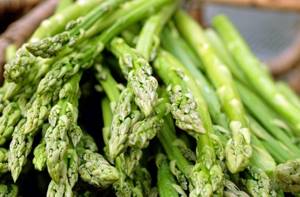
Asparagus is good for women because it has anti-inflammatory and antioxidant effects. The plant promotes the production of estrogen, so it is useful in combating menopausal symptoms. It replenishes estrogen levels and supports the body in the event of a full or partial hysterectomy.
The plant also stimulates the growth of beneficial bacteria in the intestines, soothing the stomach and aiding digestion. The anti-aging properties of asparagus increase the production of glutathione, an anti-inflammatory nutrient that can slow the action of collagen-degrading enzymes and promote wrinkles.
Asparagus extracts can be used for skin whitening. Vegetables also help relieve the symptoms of PAH, increase fertility through nutrition and strengthen the female reproductive organs.
For men
Asparagus is also beneficial for the male population. This vegetable has a significant effect on potency, libido, and helps increase hormone levels. It is worth noting that this plant has a long history of use as an aphrodisiac. Since ancient times, traditional healers have recommended asparagus to improve libido.
While breastfeeding
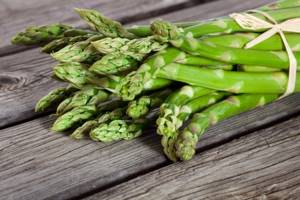
Asparagus contains tryptophan, an essential amino acid that stimulates prolactin, the hormone that produces milk.
However, it is worth remembering that asparagus is also sometimes used as a medicine. But using it as such while breastfeeding is extremely dangerous. Additionally, some women may be allergic to vegetables. It also contains carbohydrates and various sugars - glucose, fructose and galactose. The baby’s intestines do not yet contain enzymes that could effectively break down substances from asparagus
Application of the plant
Both the edible part of the plant and the spreading rhizomes hidden deep underground have beneficial properties.
Initially, only medicines were prepared from asparagus, and only then it began to be cultivated as a vegetable crop.
Asparagus in folk medicine
In folk medicine, powder from the dried rhizome is often used. It is measured out in the required quantities, poured with boiling water and medicinal infusions are prepared from it.
Less commonly, the above-ground part of the plant is used for brewing. The shoots are ground into a pulp and infusions are made from this mass. Juice is also obtained from the edible part of the plant, which is also used for medicinal purposes.
With the help of asparagus, traditional medicine offers:
- treat urinary tract diseases;
- cleanse the liver;
- strengthen the heart muscle;
- fight high blood pressure;
- lower the level of bad cholesterol;
- prevent diabetes mellitus;
- get rid of cough;
- strengthen immunity;
- fight joint pain due to rheumatism;
- treat inflammatory skin diseases.
The duration of treatment with asparagus usually does not exceed 10 days. Longer use of teas and decoctions based on the rhizome of the plant can provoke the appearance of allergic reactions.
More materials: asparagus
In cosmetology
Asparagus is used in cosmetology due to its antiseptic effect and ability to slow down aging. A decoction of asparagus is rubbed on the skin to suppress inflammation and get rid of acne. The fresh juice of the plant is used for rejuvenating purposes. It is applied to the face as a nourishing and moisturizing agent.
Rejuvenating masks are prepared from asparagus shoots by mixing the crushed mass with other natural ingredients: dairy products, vegetable juices, essential oils.
Benefits for weight loss
The dietary properties of asparagus have been mentioned more than once. It stimulates urination, forcing the body to get rid of excess water. During the asparagus diet, the severity of edema decreases, excess salts leave the body, digestion, absorption of microelements, and metabolism are normalized.
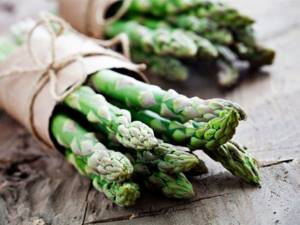
These changes lead to a natural cleansing of toxins from the body and gradual weight loss. The plant has low energy value, so it is difficult to oversaturate it.
Asparagus during pregnancy and breastfeeding: beneficial properties and contraindications
Eating asparagus during pregnancy and breastfeeding is very beneficial:
- The vitamins and microelements contained in asparagus, which are contained in a very concentrated form, unlike other vegetables, actively influence the formation of the child’s bones. These are iron, zinc, magnesium, folic acid
- Asparagus has a positive effect on the formation of the child’s connective tissues and blood formation
- Many expectant mothers often experience swelling. Asparagus will help relieve them due to its diuretic effect, and also relieves fatigue and removes unnecessary toxins, thanks to magnesium and potassium
- During pregnancy, it is very important to preserve your vision. Vitamin A in asparagus will help improve the condition of pregnant women's skin and improve vision
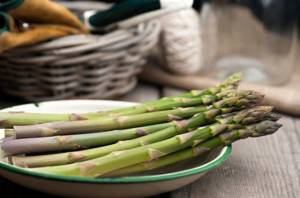
Asparagus pods There are also contraindications to eating asparagus for pregnant and breastfeeding women. The vegetable provokes allergic reactions. Check before eating asparagus for an allergen specific to you.
Also, you should not eat dishes with asparagus if the pregnant woman has stomach and digestive diseases.
Types of Asparagus
There are three types of asparagus - green, white and purple. The most common and affordable is green asparagus. It grows outdoors in the fresh air; large areas are planted with it. The shoots are collected and supplied to stores all year round.
White asparagus is more expensive, since it is grown in specially created conditions, without access to lighting and on sand. This is a more delicate product.
Purple asparagus can be found less frequently than the first two types. It turns green during cooking. It gets its purple color from being exposed to the sun for only a limited time. Unlike other types of asparagus, it has a slightly bitter, spicy taste.
Mechanism of weight loss

There are many prerequisites that served as the basis for asparagus to be part of the diet and used for weight loss.
Firstly, this is facilitated by its quantitative characteristics:
- it is low in calories: per 100 g of young shoots there are only 21 kcal;
- it contains enough proteins, practically no fat, and carbohydrates are complex, that is, useful for weight loss: the B/F/U ratio is as follows - 1.9/0.1/3.2;
- it has a low glycemic index (only 15 units), which means that it does not provoke a surge in insulin in the blood, provides long-term satiety and saves you from hunger;
- it contains only 0.25 bread units (XU), so people suffering from type I and type II diabetes mellitus can include it in their diet without fear of exceeding the daily requirement and without fear of obesity.
Secondly, it has a number of properties, due to its chemical composition (it contains many vitamins, minerals, organic acids, antioxidants, phytosterols), which trigger a number of chemical processes in the body necessary for weight loss:
- has diuretic properties, removing excess fluid from the body and eliminating swelling;
- relieves fatigue, supplying energy, which is so lacking during diets, when, against the background of food restrictions, you also have to do sports;
- cleanses the intestines of accumulated mucus, feces, toxins - laxative properties are expressed, although not clearly, but they are present and perform their functions;
- reduces appetite;
- has a calming effect on the nervous system, which helps avoid compulsive overeating;
- eliminates cellulite.
So you can eat asparagus while losing weight: there will definitely be benefits, but only if all precautions are taken. If used incorrectly, it can be harmful to health.
Is it possible to eat asparagus while losing weight?
It is asparagus that is very often used for weight loss, this is primarily due to the fact that its calorie content is only 13 kcal, but despite this, it can provide a person with a boost of energy for almost the whole day, it is also an excellent source of protein, which is important with proper weight loss.
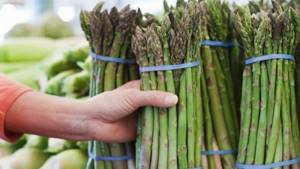
How to lose weight with asparagus:
- If you have a few extra pounds, then you can get rid of them with the help of such an amazing product as asparagus. It improves the digestion process, accelerates the metabolic process, which means that extra pounds will recede quite actively;
- asparagus contains a sufficient amount of fiber, which means that waste and toxins will be gradually eliminated from your body;
- Asparagus for weight loss is very effective because it has some diuretic effect, thus removing excess fluid from the body.
It is possible to lose weight with asparagus, you can do this in a fairly short time, in addition, the product is good for health in general, as it contains many minerals and vitamins, which is especially important during the diet.
Experts recommend eating asparagus to everyone who adheres to a healthy and balanced diet. Whether purchased or grown yourself, it is better to eat it immediately, since during storage it loses its beneficial and nutritional properties. Canned asparagus is inferior to fresh in taste and benefits.
Regular consumption of fresh this product starts the process of losing weight. If you eat 400-500 g of vegetables every day for 20 days, you can get rid of two or three extra pounds. The plant fiber contained in asparagus works for this result. It, like a sponge, cleanses the digestive tract, quickly removes excess liquid, improves digestion, and activates metabolism. The feeling of fullness lasts for a long time, you will not need snacks.
It is also used as a diuretic. The fluid content in tissues and cavities decreases, the skin becomes more elastic, dimples and tubercles in cellulite areas decrease.
When losing weight, you can eat asparagus fresh or after heat treatment. The product is baked, boiled, stewed. Canned vegetables or those cooked in vegetable oil are less useful. The vegetable is most often used as one of the ingredients in salads or served as a side dish for meat, various cereals, added to soups, and eaten as an independent product between main meals.
Asparagus is frozen and canned. Regardless of the cooking method, when prepared correctly, asparagus turns out tasty and healthy.
To achieve results, it is important not only to include asparagus in the menu, but also to completely review the daily diet and, if necessary, change eating habits. Nutritionists advise consuming asparagus in amounts of 400 to 500 g per day for several meals.
To lose weight, you need to eat the vegetable regularly for three weeks, then take a break and, if necessary, repeat the diet program to achieve a comfortable weight.
To lose weight, it is important to exclude salt, spices, mayonnaise, fatty foods, fried foods, pickles, smoked foods, baked goods, confectionery, alcohol, sweet carbonated drinks and other foods that can make you gain weight.
It is necessary to drink more fluids; in addition to water, vegetable and fruit juices, green tea, and compotes are allowed. You need to eat often up to 5-6 times a day in small portions, the last meal no later than 18.00. And most importantly, a positive result can be achieved by combining proper nutrition with physical activity.
Young and fresh shoots have a more pleasant taste, so they are more often used in cooking. Before cooking, remove the leaves and the hard part (you can freeze it and use it to make soup).
Tie the peeled asparagus into a bunch of 8-10 stalks, place in a pan filled with a small amount of water, so that the tops are not immersed in water. The asparagus is denser at the base, so while it is cooking, the tops will have time to steam.
Add a little vegetable (butter) oil, salt and sugar to taste, and the juice of half a lemon to the water. Cook over low heat: for 2-3 minutes for the green variety, and 10-15 minutes for the white variety. Check the degree of readiness with a toothpick: the stems inside should remain crispy.
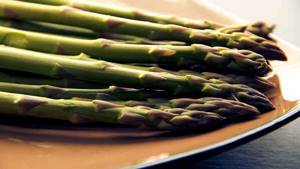
You can use a steamer to cook asparagus. The vegetable is cooked for 5-7 minutes (depending on the variety).
Recipes
Asparagus for pancreatitis and gastritis
During the treatment of pancreatitis, in the remission stage, patients are recommended to eat dishes with boiled and baked asparagus. To obtain healing properties from the vegetable and saturate the body with zinc and folic acid. Asparagus also normalizes high cholesterol. During gastritis, it is recommended to adhere to a vegetable diet, the main component of which is asparagus. It will help relieve pain symptoms and, thanks to its rich fiber content, gently cleanses the gastrointestinal tract.
Can children eat asparagus?
The beneficial properties of the product will have a beneficial effect on the developing child's body. But the plant can also cause harm - many children are allergic to this product, and it is not always easily absorbed by the intestines. The product can be offered to a child for the first time only after reaching 2 years of age, and it must be thoroughly boiled or steamed.
Attention! Since asparagus has a number of strict contraindications, you should consult your pediatrician before introducing the plant into your baby’s diet.
Asparagus is extremely beneficial for children's bodies. First of all, due to the low calorie content and high content of nutrients and vitamins. And most importantly, asparagine, which has a positive effect on the functioning of the circulatory system.
The herb helps cope with the symptoms of vitamin deficiency, gives the child a lot of energy and even improves mood. Regular consumption of food has a positive effect on the functioning of all internal organs and accelerates the process of skin regeneration. Rough cell has a positive effect on the functioning of the digestive tract. It will help cope with rare urination if the child’s problem is not associated with diseases of the genitourinary system and kidneys.
However, it is not recommended to introduce it into a baby’s diet before 10 months. At an early age, on the contrary, it can negatively affect the functioning of the gastrointestinal tract that has not yet become stronger. You should not eat asparagus if you are diagnosed with a stomach ulcer. Naturally, when introducing the product for the first time, it is necessary to monitor the child, since he may have an individual intolerance to the herb.
The product is prepared in different ways: boiled, fried, baked, steamed, pickled, etc. To prepare the green variety, plant shoots are usually used, while the white variety uses both shoots and stems.
Small subtleties
Before boiling the vegetable, it is carefully “tied” into a bundle, which consists of 10 stems. Then the asparagus is placed in a tall saucepan and some water is poured into the container. After this, you can add a small amount of sugar, salt, butter or a few slices of lemon.
Look at the same topic: Nutrition principles and permitted foods on a fermented milk diet
Cooking time directly depends on the type of vegetable. White asparagus should be cooked for about 10 minutes, green asparagus for about 3 minutes.











